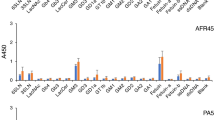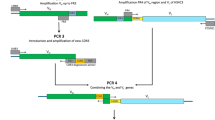Abstract
We have examined the binding and functional activity of monoclonal antibody (MAb) SG-1 that was raised by immunization against embryonal carcinoma cells and screened using KHT fibrosarcoma cells. Quantitative absorption, binding andin situ immunochemical staining assays indicate that the MAb SG-1-defined epitopes are expressed preferentially by the highly metastatic KHT35-Ll cells relative to the weakly metastatic, parental KHTp cells. Furthermore, there was a significant correlation (p<0-05) between the expression of MAb SG-1-defined antigen on the cells, following trypsin treatment, and their metastatic ability. Binding of MAb SG-1 to antigen was inhibited by specific sulfated polysaccharides including cerebroside sulfate (brain sulfatide), fucoidan, and dextran sulfate (500 kD) but not by heparan, chrondroitin, keratan or dextran (5 kD) sulfates. Initial characterization of antigen from KHT cells indicates that the epitope of MAb SG-1 is defined by sulfated glycoconjugates containing galactose and sulfate but not N-acetylglucosamine. In the total lipid extracts of KHT35-Ll cells the antigen was detected in the delipidated protein fraction as well as in the chloroform/methanol fraction. These results suggest that the sulfated glycoconjugate determinants identified by MAb SG-1 may be relevant to the metastatic process of KHT fibrosarcoma cells.
Similar content being viewed by others
References
Andrews, G. K.,Adamson, E. D., andGedamu, L., 1984, The ontogeny of expression of murine metallothionein: comparison with the a-fetoprotein gene.Developmental Biology,103, 294–303.
Blake, M. S.,Johnston, K. H.,Russell-Jones, G. J., andGotschlich, E. C., 1984, A rapid, sensitive method for detection of alkaline phosphate-conjugated anti-antibody on Western blots.Analytical Biochemistry, 36, 175–179.
Chaiet, L., andWolf, F. J., 1964, The properties of streptavidin, a biotin-binding protein produced by streptomyces.Archives of Biochemistry,106, 1–5.
Chambers, A. F.,Hill, R. P., andLing, V., 1981, Tumor heterogeneity and stability of the metastatic phenotype of mouse KHT sarcoma cells.Cancer Research,41,1368–1372.
Chambers, A. F.,Harris, J. F.,Ling, V., andHill, R. P., 1984, Rapid phenotype variation in cells derived from lung metastases of KHT fibrosarcoma.Invasion Metastasis,4, 225–237.
Iisenthal, A.,Lafreniere, R.,Lfor, A. T., andRosenberg, S. A., 1987, Effect of anti-B16 melanoma monoclonal antibody on established murine B16 melanoma liver metastases.Cancer Research,47, 2771–2776.
Esko, J. D.,Rostand, K. S., andWeinke, J. L., 1988, Tumor formation dependent on proteoglycan biosynthesis.Science,241, 1092–1096.
Gunji, Y., andTaniguchi, M., 1986, Syngeneic monoclonal anti-melanoma antibody that inhibits experimental lung metastasis of B 16 melanoma.Japanese Journal of Cancer Research,77, 595–601.
Harris, J. F., andBest, M. W., 1988, Dynamic heterogeneity: metastatic variants to liver are generated spontaneously in mouse embryonal carcinoma cells.Clinical and Experimental Metastasis,6, 451–462.
Harris, J. F.,Chambers, A. F.,Hill, R. P., andLing, V., 1982, Metastatic variants are generated spontaneously at a high rate in mouse KHT tumor.Proceedings of the National Academy of Sciences,79, 5547–5551.
Harris, J. F.,Chambers, A. F.,Ling, V., andHill, R. P., 1987, Dynamic heterogeneity: characterization of two cell lines derived from experimental lung metastases of mouse KHT fibrosarcoma.Invasion and Metastasis,7, 217–229.
Harris, J. F.,Chin, J.,Jewett, M. A. S.,Kennedy, M., andGorczynski, R. M., 1984, Monoclonal antibodies against SSEA-1 antigen: Binding properties and inhibition of human natural killer cell activity against target cells bearing SSEA-1 antigen.Journal of Immunology,132, 2502–2509.
Herd, Z. L., 1987, Suppression of B16 melanoma lung colonization by syngeneic monoclonal antibodies.Cancer Research,47, 2696–2703.
Hill, R. P.,Chambers, A. F.,Ling, V., andHarris, J. F., 1984, Dynamic heterogeneity: Rapid generation of metastatic variants in mouse B16 melanoma cells.Science,224, 998–1001.
Hofstetter, W.,Heusser, C. H.,Herschkowitz, N., andBlaser, K., 1983, Production and characterization of mouse antibodies against the brain lipid sulfatide.Journal of Immunological Methods,57, 99–109P.
Holt, G. D.,Krivan, H. C.,Gasic, G. J., andGinsburg, V., 1989, Antistasin, an inhibitor of coagulation and metastasis, binds to sulfatide (Gal(3-SO4)β1-1Cer) and has a sequence homology with other proteins that bind sulfated glycoconjugates.Journal of Biological Chemistry,264, 12138–12140.
Irimura, T.,Nakajima, M.,Yamori, T.,Ota, D. M.,Cleary, K. F., andNicolson, G. L., 1988, Glycoconjugates and tumor metastasis.Advances in Experimental Medicine and Biology,228, 677–704.
Kallman, R. F.,Silini, G., andVan Putten, L. M., 1967, Factors influencing the quantitative estimation of thein vivo survival of cells from solid tumors.Journal of the National Cancer Institute,39, 539–549.
Kimura, A. K., andXiang, J., 1986, High levels of Met-72 antigen expression: Correlation with metastatic activity of B 16 melanoma tumor cells variants.Journal of the National Cancer Institute,76, 1247–1254.
Kure, S., andYoshie, O., 1986, A syngeneic monoclonal antibody to murine meth-A sarcoma (HepSS-1) recognizes heparan sulfate glycosaminoglycan (HS-GAG): Cell density and transformation dependent alteration in cell surface HS-GAG defined by HepSS-1.Journal of Immunology,137, 3900–3908.
Kure, S.,Yoshie, O., andAso, H., 1987, Metastatic potential of murine 1316 melanoma correlates with reduced surface heparan sulfate glycosaminoglycan.Japan Journal of Cancer Research,78, 1238–1245.
Lee, H-H.,Schwartz, D. A.,Harris, J. F.,Carver, J. P., andKrepinsky, J. J., 1986, Syntheses of model oligosaccharides of biological significance. Synthesis of a fucosylated N,N′-diacetylchitobioside linked to bovine serum albumin and immunochemical characterization of rabbit antisera to this structure.Canadian Journal of Chemistry,64, 1912–1918.
Ling, V.,Chambers, A. F.,Harris, J. F., andHill, R. P., 1985, Quantitative genetic analysis of tumor progression.Cancer Metastasis Reviews,4, 173–194.
Magnani, J. L.,Spitalnik, S. L., andGinsburg, V., 1987, Antibodies against cell surface carbohydrates: Determination of antigen structure.Methods in Enzymology,138, 195–207.
Matzku, S.,Wenzel, A.,Liu, S., andZoller, M., 1989, Antigenic differences between metastatic and nonmetastatic BSp73 rat tumor variants characterized by monoclonal antibodies.Cancer Research,49, 1294–1299.
Muramatsu, T.,Gachelin, G., andJacob, F., 1979, Characterization of glycopeptides isolated from membranes of F9 embryonal carcinoma cells.Biochimica et Biophysica Acta,587, 392–406.
North, S. M.,Steck, P. A., andNicolson, G. L., 1986, Monoclonal antibodies against cell-surface antigens of the metastatic rat 11762NF mammary adenocarcinoma and their cross-reactivity with human breast carcinomas.Cancer Research,46, 6393–6399.
Olsson, L., andFporchhammer, J., 1984, Induction of the metastatic phenotype in a mouse tumor model by 5-azacytidine, and characterization of an antigen associated with metastatic activity.Proceedings of the National Academy of Science, U.S.A.,81, 3389–3393.
Redini, F.,Moczar, E., andPoupon, M. F., 1986, Cell surface glycosaminoglycans of rat rhabdomyosarcoma lines with different metastatic potentials and non-malignant rat myoblasts.Biochimica et Biophysica Acta,883, 98–105.
Roberts, D. D.,Haverstick, D. M.,Dixit, V. M.,Frazier, W. A.,Santoro, S. A., andGinsburg, V., 1985, The platelet glycoprotein thrombospondin binds specifically to sulfated glycolipids.Journal of Biological Chemistry,260, 9405–9411.
Roberts, D. D.,Rao, C. N.,Magnani, J. L.,Spitalnik, S. L.,Liotta, L. A., andGinsburg, V., 1985, Laminin binds specifically to sulfated glycolipids.Proceedings of the National Academy of Sciences, U.S.A.,82, 1306–1310.
Roberts, D. D.,Rao, C. N., andLiotta, L. A., 1986, Comparison of the specificities of laminin, thrombospondin, and von Willebrand factor for binding to sulfated clycolipids.Journal of Biological Chemistry,261, 6872–6877.
Roberts, D. D., 1987, Sulfatide-binding proteins.Methods in Enzymology,138, 473–483.
Roberts, D. D., andGinsburg, V., 1988, Sulfated glycolipids and cell adhesion.Archives of Biochemistry and Biophysics,267, 405–415.
Rosenstraus, M. J., 1983, Isolation and characterization of an embryonal carcinoma cell line lacking SSEA-1 antigen.Developmental Biology,99, 318–323.
Roux, L.,Holojda, S.,Sundblad, G.,Freeze, H. H., andVArki, A., 1988, Sulfated Nlinked oligosaccharides in mammalian cells. 1. Complex chains with sialic acids and O-sulfate esters.Journal of Biological Chemistry,263, 8879–8889.
Russell, W. C.,Newman, C., andWilliamson, D. H., 1975, A simple cytochemical technique for demonstration of DNA in cells infected with mycoplasmas and viruses.Nature,253, 461–462.
Sacchi, A.,Kennel, S.,Natali, P. G.,Tibursi, G., andGhetti, C. A., 1987, Metastatic dissemination of 3LL variants after treatment with monoclonal antibody to a tumor-associated antigen.Clinical and Experimental Metastasis,5, 245–257.
Sacchi, A.,KEnnel, S. J.,Apollonj, C., andNatali, P. G., 1985, Treatment with monoclonal antibody to a Lewis lung carcinoma-associated antigen: Different effects on primary tumor and its metastases.Cancer Treatment Reports,69, 985–991.
Scudder, P.,Hanfland, P.,Femura, K., andFeizi, T., 1984, Endo-beta-d-galactosidases ofBacteroides fragilis andEscherichia freundii hydrolyze linear but not branched oligosaccharide domains of glycolipids of the neolacto series.Journal of Biological Chemistry, 25 (259), 6586–6592.
Shively, J. E., andConrad, H. E., 1976, Formation of anhydrosugars in the chemical depolymerization of heparin.Biochemistry,15, 3932–3942.
Shulman, M.,Wilde, C. D., andKohler, G., 1978, A better cell line for making hybridomas secreting specific antibodies.Nature,276, 269–270.
Siraganian, R. P.,Fox, P. C., andBerenstein, E. H., 1983, Methods of enhancing the frequency of antigen-specific hybridomas.Methods in Enzymology,92, 17–26.
Steck, P. A.,Cheong, P. H.,Nakajima, M.,Yung, W. K. A.,Moser, R. P., andNicolson, G. L., 1987, Altered expression of glycosaminoglycans in metastatic 13762NF rat mammary adenocarcinoma cells.Biochemistry,26, 1020–1028.
Stocker, J. W., andHeusser, C. H., 1979, Methods for binding cells to plastic: application to a solid-phase radioimmunoassay for cell-surface antigens.Journal of Immunological Methods,26, 87–95.
Timar, J.,Moczar, E.,Timar, F.,Pal, K.,Kopper, L.,Lapis, K., andJeney, A., 1987, Comparative study of Lewis lung tumor lines with ‘low’ and igh’ metastatic capacity. II. Cytochemical and biochemical evidence for differences in glycosaminoglycans.Clinical and Experimental Metastasis,5, 79–87.
Tuszynski, G. P.,Gasic, T. B., andGasic, G. J., 1987,Isolation and characterization of antistasin, an inhibitor of metastasis and coagulation. Journal of Biological Chemistry,262,9718–9723.
Vollmers, H. P., andBirchmeier, W., 1983, Monoclonal antibodies inhibit the adhesion of mouse B16 melanoma cellsin vitro and block lung metastasisin vivo.Proceedings of the National Academy of Sciences, U.S.A.,80, 3729–3733.
Vollmers, H. P., andBirchmeier, W., 1983, Monoclonal antibodies that prevent adhesion of B16 melanoma cells and reduce metastasis in mice: Cross reaction with human tumor cells.Proceedings of the National Academy of Sciences, U.S.A.,80, 6863–6867.
Wasteson, A.,Uthne, K., andWestermark, B., 1973, A novel assay for the biosynthesis of sulphated polysaccharide and its application to studies on the effects of somatomedin on cultured cells.Biochemical Journal,136, 1069–1074.
Woodward, M. P.,Young, Jr, W. W., andBloodgood, R. A., 1985, Detection of monoclonal antibodies specific for carbohydrate epitopes using periodate oxidation.Journal of Immunological Methods,78, 143–153.
Xiang, J., andKimura, A. K., 1986,In vitro modulation of the metastatic phenotype. I. Analysis of differentiation forms of the B16 melanoma expressing Met-72 determinants and metastatic activity.Clinical and Experimental Metastasis,4, 293–309.
Xiang, J., andKimura, A. K., 1987, Isolation of metastatic B16 melanoma variants using anti-Met 72 monoclonal antibodies and flow cytometry.Clinical and Experimental Metastasis,5, 35–42.
Author information
Authors and Affiliations
Rights and permissions
About this article
Cite this article
Harris, J.F., Beaton, D.W. Sulfated glycoconjugate determinants recognized by monoclonal antibody, SG-1, correlate with the experimental metastatic ability of KHT fibrosarcoma cells. Clin Exp Metast 8, 361–379 (1990). https://doi.org/10.1007/BF01810681
Received:
Accepted:
Issue Date:
DOI: https://doi.org/10.1007/BF01810681




